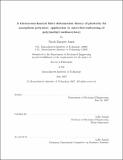| dc.contributor.advisor | Lallit Anand. | en_US |
| dc.contributor.author | Ames, Nicoli M. (Nicoli Margret), 1978- | en_US |
| dc.contributor.other | Massachusetts Institute of Technology. Dept. of Mechanical Engineering. | en_US |
| dc.date.accessioned | 2008-09-02T17:57:59Z | |
| dc.date.available | 2008-09-02T17:57:59Z | |
| dc.date.copyright | 2007 | en_US |
| dc.date.issued | 2007 | en_US |
| dc.identifier.uri | http://hdl.handle.net/1721.1/42068 | |
| dc.description | Thesis (Ph. D.)--Massachusetts Institute of Technology, Dept. of Mechanical Engineering, 2007. | en_US |
| dc.description | This electronic version was submitted by the student author. The certified thesis is available in the Institute Archives and Special Collections. | en_US |
| dc.description | Includes bibliographical references. | en_US |
| dc.description.abstract | Amorphous thermoplastic polymers are important engineering materials; however, their nonlinear, strongly temperature- and rate-dependent elastic-visco-plastic behavior has, until now, not been very well understood. The behavior has previously been modeled with mixed success by existing constitutive theories. As a result, there is currently no generally agreed upon theory to model the large-deformation, thermo-mechanically coupled, elasto-visco-plastic response of amorphous polymeric materials spanning their glass transition temperatures. What is needed is a unified constitutive framework that is capable of capturing the transition from a visco-elastic-plastic solidlike response below the glass transition temperature, to a rubbery-viscoelastic response above the glass transition temperature, to a fluid-like response at yet higher temperatures. We have developed a continuum-mechanical constitutive theory aimed to fill this need. The theory has been specialized to represent the salient features of the mechanical response of poly(methyl methacrylate) in a temperature range spanning room temperature to 60C above the glass transition temperature #g 110C of the material, in a strain-rate range of 10-4/s to 10-1/s, and under compressive stress states in which this material does not exhibit crazing. We have implemented our theory in the finite element program ABAQUS/Explicit. The numerical simulation capability of the theory is demonstrated with simulations of the micron-scale hot-embossing process for manufacture of microfluidic devices. | en_US |
| dc.description.statementofresponsibility | by Nicoli Margaret Ames. | en_US |
| dc.format.extent | 217 p. | en_US |
| dc.language.iso | eng | en_US |
| dc.publisher | Massachusetts Institute of Technology | en_US |
| dc.rights | M.I.T. theses are protected by
copyright. They may be viewed from this source for any purpose, but
reproduction or distribution in any format is prohibited without written
permission. See provided URL for inquiries about permission. | en_US |
| dc.rights.uri | http://dspace.mit.edu/handle/1721.1/7582 | en_US |
| dc.subject | Mechanical Engineering. | en_US |
| dc.title | A thermo-mechanical finite deformation theory of plasticity for amorphous polymers : application to micro-hot-embossing of poly(methyl methacrylate) | en_US |
| dc.type | Thesis | en_US |
| dc.description.degree | Ph.D. | en_US |
| dc.contributor.department | Massachusetts Institute of Technology. Department of Mechanical Engineering | |
| dc.identifier.oclc | 232155911 | en_US |
